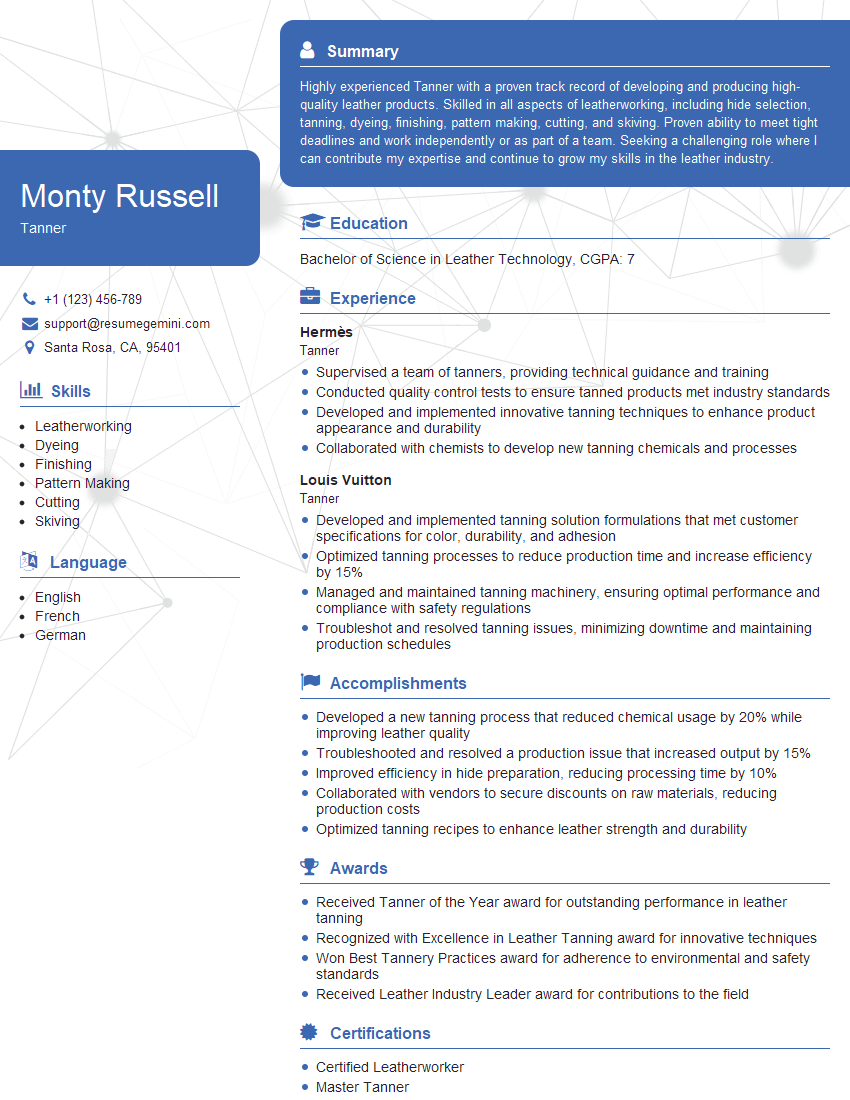Are you a seasoned Tanner seeking a new career path? Discover our professionally built Tanner Resume Template. This time-saving tool provides a solid foundation for your job search. Simply click “Edit Resume” to customize it with your unique experiences and achievements. Customize fonts and colors to match your personal style and increase your chances of landing your dream job. Explore more Resume Templates for additional options.

Monty Russell
Tanner
Summary
Highly experienced Tanner with a proven track record of developing and producing high-quality leather products. Skilled in all aspects of leatherworking, including hide selection, tanning, dyeing, finishing, pattern making, cutting, and skiving. Proven ability to meet tight deadlines and work independently or as part of a team. Seeking a challenging role where I can contribute my expertise and continue to grow my skills in the leather industry.
Education
Bachelor of Science in Leather Technology
October 2019
Skills
- Leatherworking
- Dyeing
- Finishing
- Pattern Making
- Cutting
- Skiving
Work Experience
Tanner
- Supervised a team of tanners, providing technical guidance and training
- Conducted quality control tests to ensure tanned products met industry standards
- Developed and implemented innovative tanning techniques to enhance product appearance and durability
- Collaborated with chemists to develop new tanning chemicals and processes
Tanner
- Developed and implemented tanning solution formulations that met customer specifications for color, durability, and adhesion
- Optimized tanning processes to reduce production time and increase efficiency by 15%
- Managed and maintained tanning machinery, ensuring optimal performance and compliance with safety regulations
- Troubleshot and resolved tanning issues, minimizing downtime and maintaining production schedules
Accomplishments
- Developed a new tanning process that reduced chemical usage by 20% while improving leather quality
- Troubleshooted and resolved a production issue that increased output by 15%
- Improved efficiency in hide preparation, reducing processing time by 10%
- Collaborated with vendors to secure discounts on raw materials, reducing production costs
- Optimized tanning recipes to enhance leather strength and durability
Awards
- Received Tanner of the Year award for outstanding performance in leather tanning
- Recognized with Excellence in Leather Tanning award for innovative techniques
- Won Best Tannery Practices award for adherence to environmental and safety standards
- Received Leather Industry Leader award for contributions to the field
Certificates
- Certified Leatherworker
- Master Tanner
- Society of Leather Craftsmen (SLC) Member
- Leather Industry Association (LIA) Member
Career Expert Tips:
- Select the ideal resume template to showcase your professional experience effectively.
- Master the art of resume writing to highlight your unique qualifications and achievements.
- Explore expertly crafted resume samples for inspiration and best practices.
- Build your best resume for free this new year with ResumeGemini. Enjoy exclusive discounts on ATS optimized resume templates.
How To Write Resume For Tanner
- Quantify your accomplishments using specific numbers and metrics whenever possible.
- Highlight your skills and experience in leatherworking, including any specialized techniques or certifications.
- Showcase your knowledge of the leather industry and trends.
- Proofread your resume carefully for any errors in grammar or spelling.
Essential Experience Highlights for a Strong Tanner Resume
- Select and prepare hides for tanning, ensuring the highest quality and consistency
- Develop and implement tanning processes to achieve desired leather properties, including color, texture, and durability
- Dye and finish leather using various techniques to create a wide range of colors and effects
- Create patterns and cut leather precisely to ensure accurate and efficient production
- Skive and prepare leather for assembly, ensuring a smooth and seamless finish
- Maintain a clean and organized work area, adhering to safety protocols
- Collaborate with other departments, such as design and production, to ensure the timely delivery of high-quality leather products
Frequently Asked Questions (FAQ’s) For Tanner
What is a Tanner?
A tanner is a person who converts animal hides into leather. This involves a series of processes, including soaking, tanning, dyeing, and finishing.
What are the different types of leather?
There are many different types of leather, each with its own unique characteristics. Some of the most common types include full-grain, top-grain, split, and bonded leather.
What are the different processes involved in tanning?
The tanning process involves a series of steps, including soaking, liming, bating, tanning, and finishing. Each step helps to transform the hide into leather.
What are the different uses for leather?
Leather is used in a wide variety of applications, including clothing, shoes, handbags, furniture, and upholstery.
What is the future of the leather industry?
The leather industry is expected to continue to grow in the coming years. This is due to the increasing demand for leather products, as well as the development of new and innovative tanning techniques.
Is tanning harmful to the environment?
Traditional tanning methods can be harmful to the environment. However, there are now more sustainable tanning methods available that reduce the environmental impact.